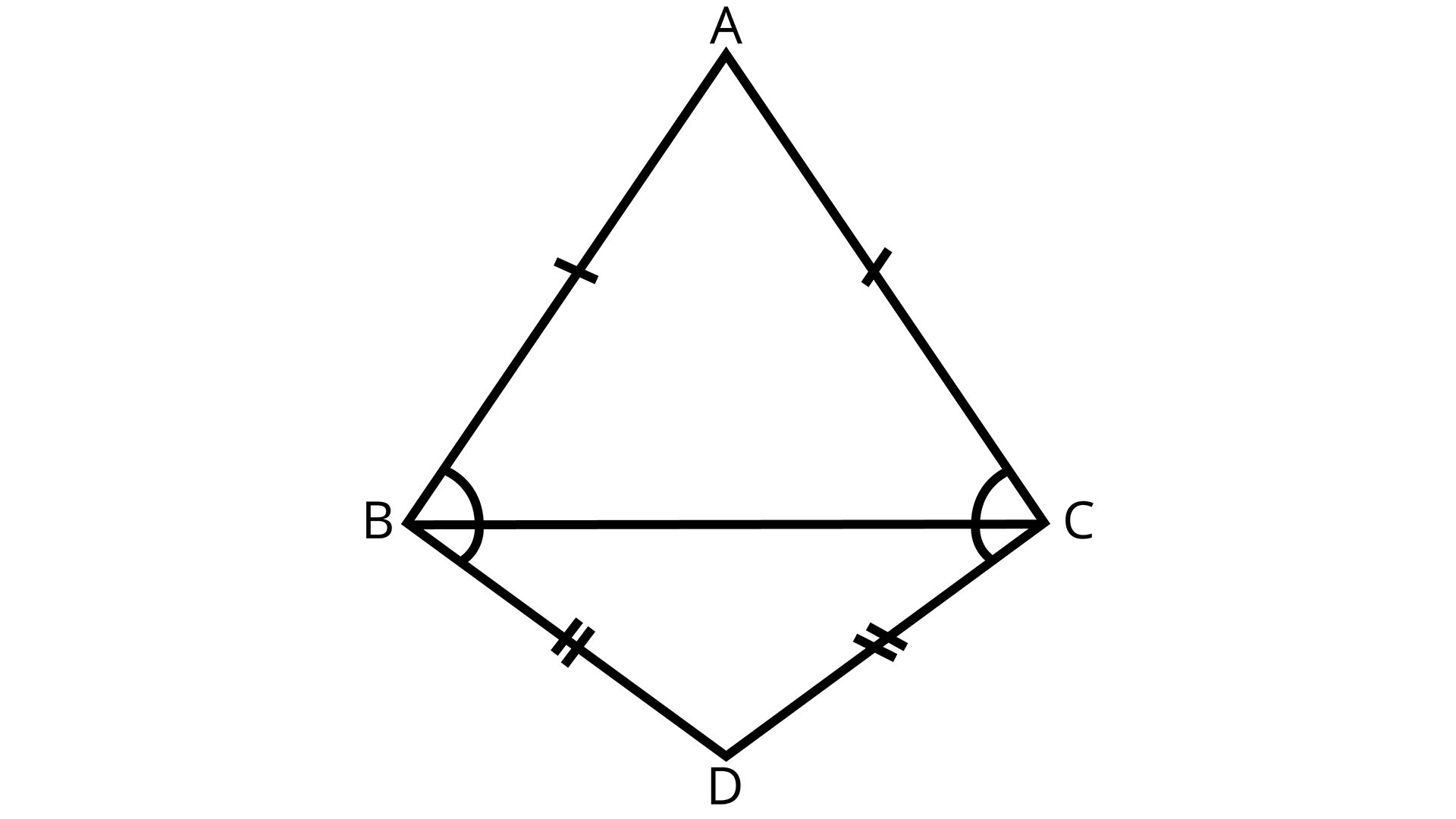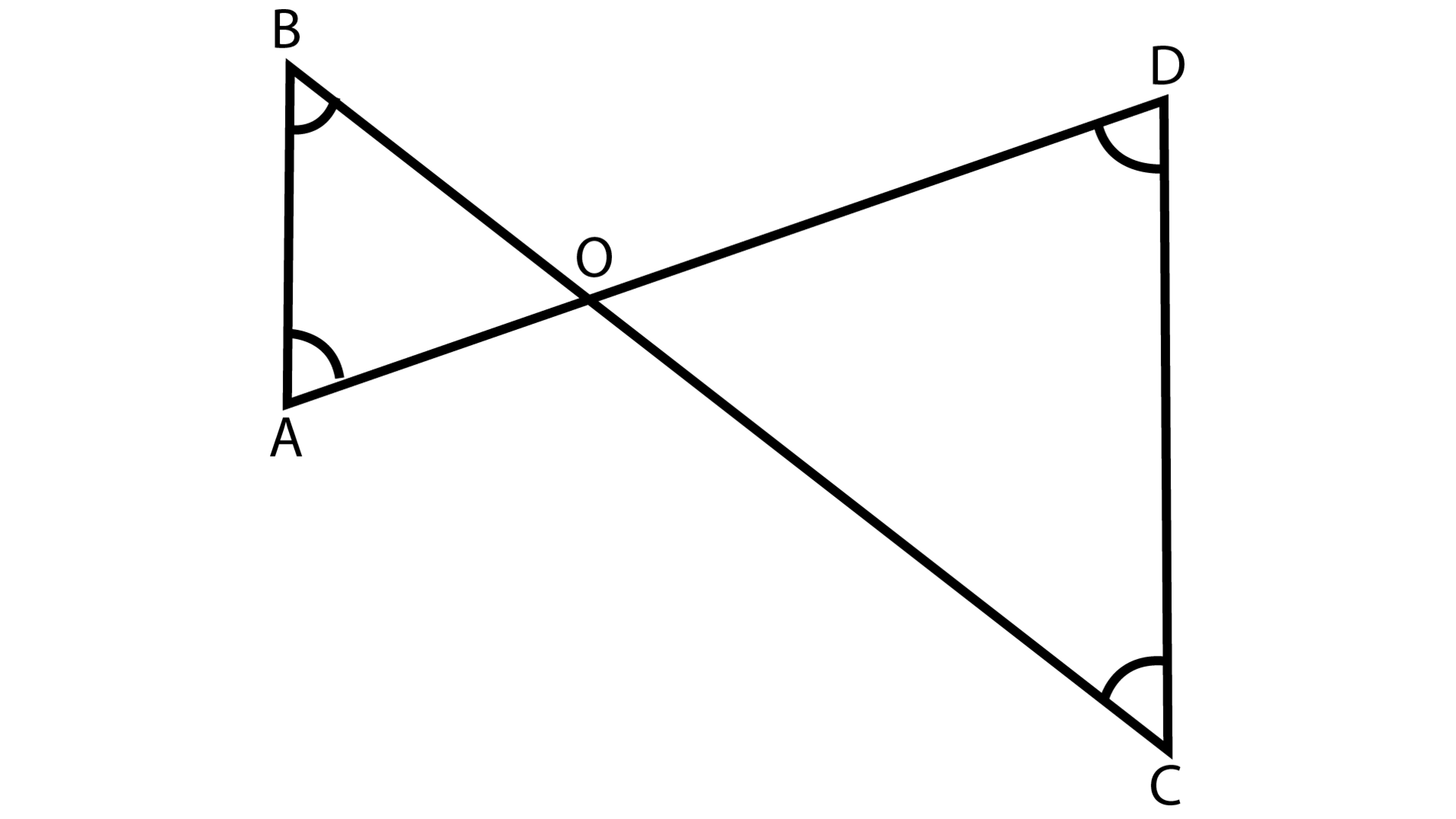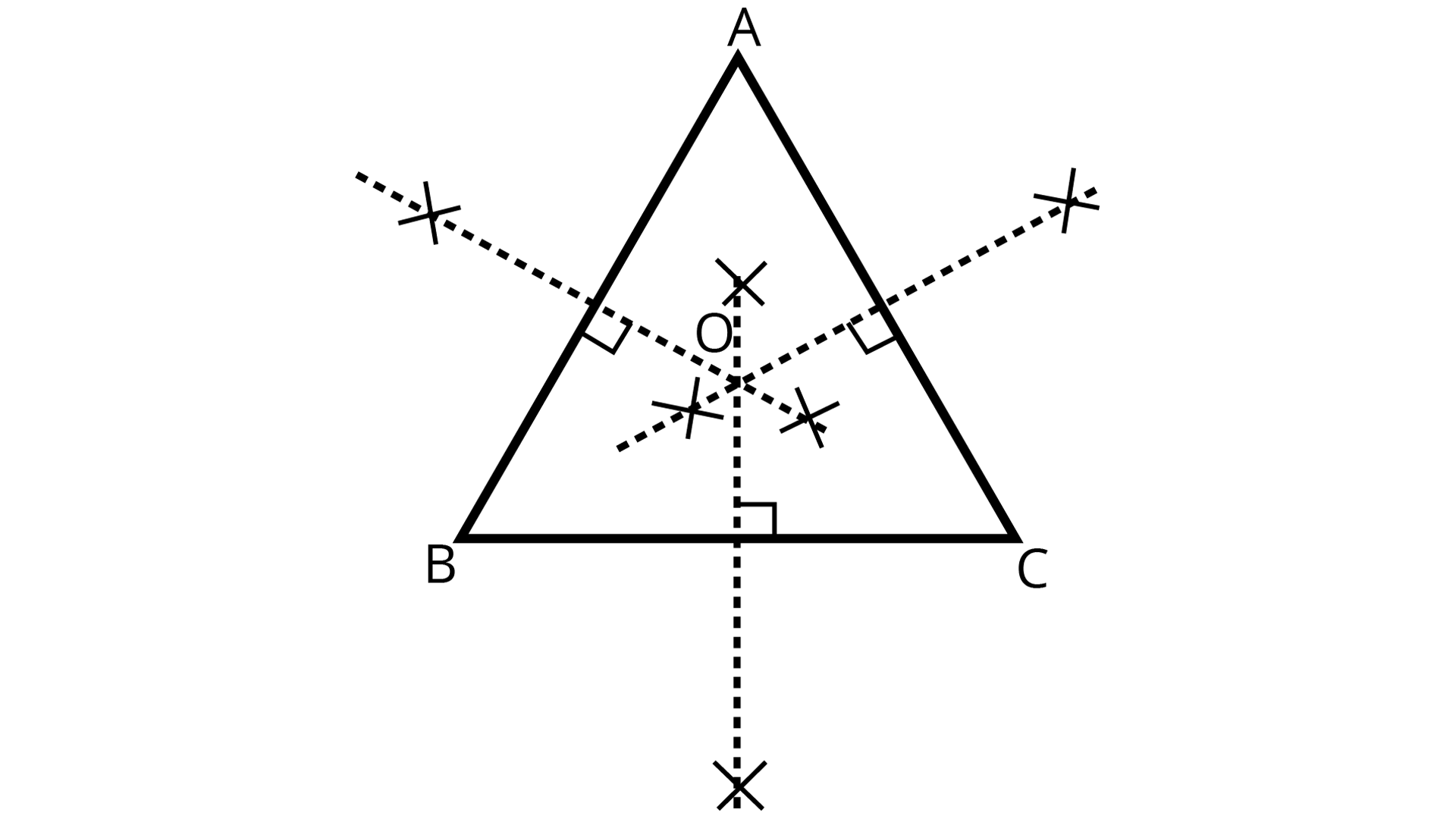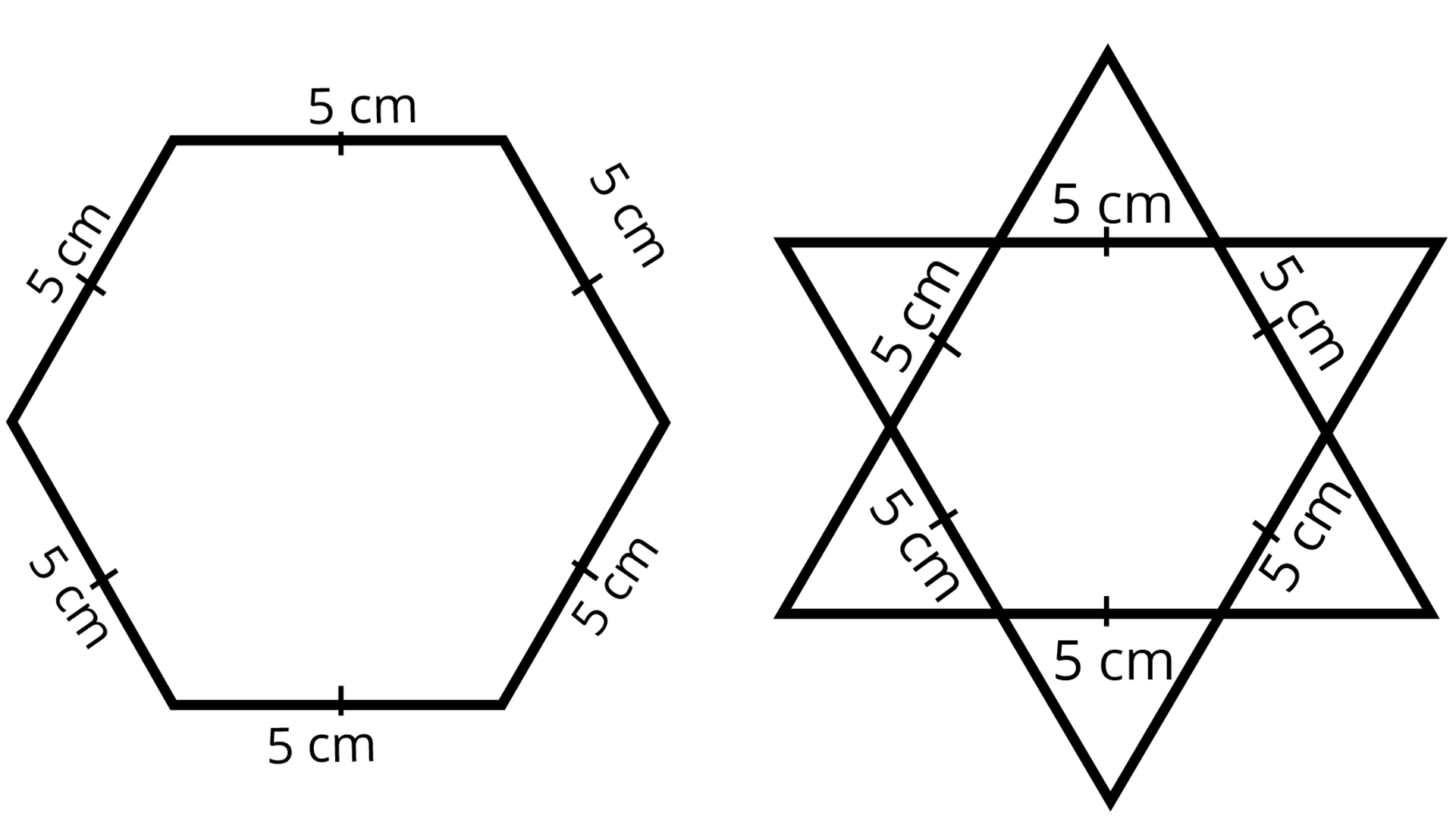Class 9 Maths NCERT Solutions Chapter 7 Free PDF Download
NCERT Maths class 9 chapter 7 is an important chapter that teaches students about triangles. In this chapter, students learn about the different types of triangles along with the properties of triangles. There are also many important questions, formulas, and theorems in this chapter.
Students can download NCERT solutions for class 9 maths ch 7 from Vedantu. At Vedantu, we have discussed everything that students need to learn about this chapter. The maths NCERT solutions class 9 chapter 7 are available in a pdf format. You can download ch 7 maths class 9 NCERT book solutions from Vedantu for free! Students can also download Class 9 Science PDFs from our official website for free.
NCERT Solutions for Class 9 Maths Chapter 7 Triangles

 Share
Share
Exercises under NCERT Solutions for Class 9 Maths Chapter 7 Triangles
NCERT Solutions for Class 9 Maths Chapter 7, "Triangles," is a crucial chapter for students as it provides the basic foundation for higher-level geometry. The chapter mainly focuses on the properties and theorems of triangles, their congruence, and their similarity. There are five exercises in this chapter, and each of them deals with different kinds of questions related to triangles. Here's a brief overview of each exercise:
Exercise 7.1: This exercise comprises eight questions, and it mainly deals with the basic properties of triangles such as interior angles, exterior angles, and inequalities. The questions are mostly objective and require students to apply simple formulas to find the values of angles and sides of triangles.
Exercise 7.2: This exercise consists of eight questions and mainly focuses on the congruence of triangles. The questions in this exercise deal with the criteria for congruence of triangles such as SSS, SAS, ASA, RHS, and AAS. The questions require students to apply these criteria to determine if the given triangles are congruent or not.
Exercise 7.3: This exercise comprises five questions, and it deals with the properties of isosceles and equilateral triangles. The questions in this exercise require students to apply the properties of these triangles to find the values of angles and sides.
Exercise 7.4: This exercise consists of six questions and mainly focuses on the inequalities in triangles. The questions in this exercise deal with the triangle inequality theorem and the converse of the same. The questions require students to apply these theorems to determine if a triangle can be formed with the given sides or not.
Exercise 7.5: This exercise comprises four questions and deals with the similarity of triangles. The questions in this exercise require students to apply the criteria for the similarity of triangles such as AA, SAS, and SSS. The questions require students to find the values of the sides and angles of similar triangles.
Access NCERT Answers for Class-9 Maths Chapter 7 – Triangles
Exercise-7.1
1. In quadrilateral ACBD, AC = AD and AB bisects \[\angle A\] (See the given figure). Show that \[\Delta ABC{\text{ }} \cong \Delta ABD\]. What can you say about BC and BD?

Quadrilateral ABCD
Ans: Given: In quadrilateral ACBD, AC = AD and AB is bisected by \[\angle A\]
To find: Show that \[\Delta ABC{\text{ }} \cong \Delta ABD\].
In \[\Delta ABC{\text{ , }}\Delta ABD\]
\[AC{\text{ }} = {\text{ }}AD\] (Given)
\[\angle CAB{\text{ }} = \angle DAB\] (AB bisects ∠A)
\[AB{\text{ }} = {\text{ }}AB\] (Common)
\[\therefore \Delta ABC{\text{ }} \cong \Delta ABD\] (By SAS congruence rule)
\[\therefore BC{\text{ }} = {\text{ }}BD\] (By CPCT)
Therefore, BC and BD are of equal lengths.
2. ABCD is a quadrilateral in which AD = BC and \[\angle DAB{\text{ }} = \angle CBA\] (See the given figure). Prove that
(i) \[\Delta ABD{\text{ }} \cong \Delta BAC\]
(ii) BD = AC
(iii)\[\angle ABD{\text{ }} = \angle BAC\].

Quadrilateral ABCD with AD = BC
Ans : Given: ABCD is a quadrilateral where AD = BC and \[\angle DAB{\text{ }} = \angle CBA\]
To prove:
(i) \[\Delta ABD{\text{ }} \cong \Delta BAC\]
(ii) BD = AC
(iii)\[\angle ABD{\text{ }} = \angle BAC\].
In \[\Delta ABD{\text{ , }}\Delta BAC\],
AD = BC (Given)
\[\angle DAB{\text{ }} = \angle CBA\] (Given)
AB = BA (Common)
\[\therefore \Delta ABD{\text{ }} \cong \Delta BAC\] (By SAS congruence rule)
\[\therefore BD{\text{ }} = {\text{ }}AC\] (By CPCT)
And, \[\angle ABD{\text{ }} = \angle BAC\] (By CPCT)
3. AD and BC are equal perpendiculars to a line segment AB (See the given figure). Show that CD bisects AB.

Figure showing AD and BC equal perpendiculars to a line segment AB
Ans: Given: AD and BC are equal perpendiculars to a line segment AB
To prove: CD bisects AB.
In \[\Delta BOC{\text{ , }}\Delta AOD\],
\[\angle BOC{\text{ }} = \angle AOD\] (Vertically opposite angles)
\[\angle CBO{\text{ }} = \angle DAO\] (Each right angle )
BC = AD (Given)
\[\therefore \Delta BOC{\text{ }} \cong \Delta AOD\] (AAS congruence rule)
\[\therefore BO{\text{ }} = {\text{ }}AO\] (By CPCT)
\[ \Rightarrow \]CD bisects AB.
4. l and m are two parallel lines intersected by another pair of parallel lines p and q (see the given figure). Show that \[\Delta ABC \cong \Delta CDA\].

Two Parallel Lines L and M
Given: l and m are two parallel lines intersected by another pair of parallel lines p and q To prove: \[\Delta ABC \cong \Delta CDA\].
In \[\Delta ABC{\text{ , }}\Delta CDA\],
\[\angle BAC{\text{ }} = \angle DCA\] (Alternate interior angles, as\[p{\text{ }}||{\text{ }}q\])
2AC = CA (Common)
\[\angle BCA{\text{ }} = \angle DAC\] (Alternate interior angles, as \[l{\text{ }}||{\text{ }}m\])
\[\therefore \Delta ABC \cong \Delta CDA\] (By ASA congruence rule)
5. Line l is the bisector of an angle \[\angle A\] and B is any point on l. BP and BQ are $$perpendiculars from B to the arms of \[\angle A\] (see the given figure). Show that:

Line l the Bisector of an Angle A
(i) \[\Delta APB \cong \Delta AQB\]
(ii) BP = BQ or B is equidistant from the arms of ∠A.
Ans: Given: Line l is the bisector of an angle \[\angle A\] and B is any point on l.
To prove: (i) \[\Delta APB \cong \Delta AQB\]
(ii) \[BP{\text{ }} = {\text{ }}BQ\] or B is equidistant from the arms of \[\angle A\].
In \[\Delta APB{\text{ , }}\Delta AQB\],
\[\angle APB{\text{ }} = \angle AQB\] (Each right angle )
\[\angle PAB{\text{ }} = \angle QAB\] (l is the angle bisector of \[\angle A\])
AB = AB (Common)
\[\therefore \Delta APB \cong \Delta AQB\] (By AAS congruence rule)
\[\therefore BP{\text{ }} = {\text{ }}BQ\] (By CPCT)
Or, it can be said that B is equidistant from the arms of \[\angle A\].
6. In the given figure, \[AC{\text{ }} = {\text{ }}AE,{\text{ }}AB{\text{ }} = {\text{ }}AD\] and \[\angle BAD{\text{ }} = \angle EAC\]. Show that BC = DE.
Ans:

Angle BAD = angle EAC
Given: \[\angle BAD{\text{ }} = \angle EAC\]
To prove: BC = DE
It is given that \[\angle BAD{\text{ }} = \angle EAC\]
\[\angle BAD{\text{ }} + \angle DAC{\text{ }} = \angle EAC{\text{ }} + \angle DAC\]
\[\angle BAC{\text{ }} = \angle DAE\]
In \[\Delta BAC{\text{ , }}\Delta DAE\],
AB = AD (Given)
\[\angle BAC{\text{ }} = \angle DAE\] (Proved above)
AC = AE (Given)
\[\therefore \Delta BAC{\text{ }} \cong \Delta DAE\] (By SAS congruence rule)
\[\therefore BC{\text{ }} = {\text{ }}DE\] (By CPCT)
7. AB is a line segment and P is its mid-point. D and E are points on the same side of AB such that \[\angle BAD{\text{ }} = \angle ABE\] and \[\angle EPA{\text{ }} = \angle DPB\] (See the given figure). Show that

Line segment AB with its mid point P
(i) \[\Delta DAP \cong \Delta EBP\]
(ii) AD = BE
Ans: Given: AB is a line segment and P is its mid-point. D and E are points on the same side of AB such that \[\angle BAD{\text{ }} = \angle ABE\] and \[\angle EPA{\text{ }} = \angle DPB\]
To prove: (i) \[\Delta DAP \cong \Delta EBP\]
(ii) AD = BE
It is given that \[\angle EPA{\text{ }} = \angle DPB\]
\[\angle EPA{\text{ }} + \angle DPE{\text{ }} = \angle DPB{\text{ }} + \angle DPE\]
\[\therefore \angle DPA{\text{ }} = \angle EPB\]
In \[\Delta DAP{\text{ , }}\Delta EBP\],
\[\angle DAP{\text{ }} = \angle EBP\] (Given)
AP = BP (P is mid-point of AB)
\[\angle DPA{\text{ }} = \angle EPB\] (From above)
\[\therefore \Delta DAP \cong \Delta EBP\] (ASA congruence rule)
\[\therefore AD{\text{ }} = {\text{ }}BE\] (By CPCT)
8. In right triangle ABC, right angled at C, M is the mid-point of hypotenuse AB. C is joined to M and produced to a point D such that DM = CM. Point D is joined to point B (see the given figure). Show that:

Triangle ABC right - angled at C and midpoint M of AB
i) \[\Delta AMC \cong \Delta BMD\]
ii) \[\angle DBC\] is a right angle.
iii) \[\Delta DBC \cong \Delta ACB\]
iv) \[CM{\text{ }} = {\text{ }}\dfrac{1}{2}{\text{ }}AB\]
Ans: Given: M is the mid-point of hypotenuse AB. DM = CM
(i) In \[\Delta AMC{\text{ }},{\text{ }}\Delta BMD\],
AM = BM (M is the mid-point of AB)
\[\angle AMC{\text{ }} = \angle BMD\] (Vertically opposite angles)
CM = DM (Given)
\[\therefore \Delta AMC \cong \Delta BMD\] (By SAS congruence rule)
\[\therefore AC{\text{ }} = {\text{ }}BD\] (By CPCT)
And, \[\angle ACM{\text{ }} = \angle BDM\](By CPCT)
(ii) \[\angle ACM{\text{ }} = \angle BDM\]
However, \[\angle ACM{\text{ , }}\angle BDM\] are alternate interior angles.
Since alternate angles are equal,
It can be said that \[DB{\text{ }}||{\text{ }}AC\]
(Co-interior angles)
(iii) In \[\Delta DBC{\text{ , }}\Delta ACB\],
DB = AC (Already proved)
\[\angle DBC{\text{ }} = \angle ACB\] (Each \[{90^o}\])
BC = CB (Common)
\[\therefore \Delta DBC \cong \Delta ACB\] (SAS congruence rule)
(iv) \[\therefore \Delta DBC \cong \Delta ACB\]
AB = DC (By CPCT)
AB = 2 CM
\[CM{\text{ }} = {\text{ }}\dfrac{1}{2}{\text{ }}AB\]
Exercise (7.2)
1. In an isosceles triangle ABC, with AB = AC, the bisectors of ∠B and ∠C intersect each other at O. Join A to O. Show that:
(i) OB = OC (ii) AO bisects ∠A

Isosceles triangle with AB = AC
Ans: We know, $\angle ABC = \angle ACB$ ${\text{[Equal angles of isosceles triangle]}}$
$ \Rightarrow \dfrac{1}{2}\angle ABC = \dfrac{1}{2}ACB$
$ \Rightarrow \angle OBC = \angle OCB$
$\therefore OB = OC$ ${\text{[Sides opposite to equal angles of Isosceles triangle are equal]}}$
Now, In $\Delta ABO$ and $\Delta ACO$,
$AB = AC$ ${\text{[Equal sides of Isosceles triangle]}}$
$OB = OC$ ${\text{[Proved above]}}$
AO=AO [Common]
$\therefore \Delta ABO \cong \Delta ACO$ ${\text{[By SSS]}}$
$\therefore \angle BAO = \angle CAO$ ${\text{[CPCT]}}$
$\therefore $ AO bisects angle A.
2. In ΔABC, AD is the perpendicular bisector of BC (see the given figure). Show that ΔABC is an isosceles triangle in which AB = AC.

Triangle ABC , AD being the bisector of BC
Ans: $\because $ AD is perpendicular bisector of BC,
$\therefore $$BD = DC$
& $\angle ADB = \angle ADC$ ${\text{[Each 90°]}}$
Now, in$\Delta ABD$ and $\Delta ACD$,
$AD = AD$ (Common)
$\angle ADB = \angle ADC$ ${\text{[Proved above]}}$ $BD = CD$ ${\text{[Proved above]}}$
$\therefore \Delta ADB \cong \Delta ACD$ ${\text{[by SAS]}}$
$\therefore AB = AC$ (CPCT)
So, $\Delta ABC$ is an isosceles triangle with \[AB = AC\]
3. ABC is an isosceles triangle in which altitudes BE and CF are drawn to equal sides AC and AB respectively (see the given figure). Show that these altitudes are equal.

Isosceles triangle ABC
Ans: In $\Delta ABE$and $\Delta ACF$,
$\angle AEB = \angle AFE$ ${\text{[Each 90°]}}$
$\angle BAE = \angle CAF$ (Common)
$AB = AC$ [Given]
$\therefore \Delta ABE \cong \Delta ACF$ ${\text{[By AAS]}}$
$\therefore BE = CF$ (CPCT)
4. ABC is a triangle in which altitudes BE and CF to sides AC and AB are equal (see the given figure). Show that
(i) \[\Delta ABE \cong \Delta ACF\]
(ii) AB = AC i.e., ABC is an isosceles triangle

Triangle ABC with equal altitudes
Ans: In $\Delta ABE$and $\Delta ACF$,
\[\angle BAE = \angle CAF\] (Common)
$\angle BEA = \angle CFA$ ${\text{[Each 90°]}}$
$BE = CF$ [Given]
$\therefore \Delta ABE \cong \Delta ACF$ ${\text{[by AAS]}}$
$\therefore AB = AC$ (CPCT)
And therefore, $\Delta ABC$ is an isosceles triangle with AB=AC.
5. ABC and DBC are two isosceles triangles on the same base BC (see the given figure). Show that ∠ABD = ∠ACD.

Two Isosceles Triangles
Ans: Since AB=AC, and DB=DC,
$\therefore $ABDC is a quadrilateral with adjacent sides being equal.
$ \Rightarrow $ABDC is a kite.
We know that one pair of opposite (obtuse) angles of kite are equal.
Hence, $\angle ABD = \angle ACD$
6. ΔABC is an isosceles triangle in which AB = AC. Side BA is produced to D such that AD = AB (see the given figure). Show that ∠BCD is a right angle.

Isosceles Triangle in which AB = AC
Ans: In $\Delta ABC$
$\angle ABC = \angle ACB$ ${\text{[angles opposite to equal sides of a triangle]}}$ … (1)
Similarly, in $\Delta ADC$
$\angle ADC = \angle ACD$ ${\text{[angles opposite to equal sides of a triangle]}}$ … (2)
Now since BD is a straight line,
$\angle BAC + \angle CAD = 180^\circ $ … (3)
And we know,
$\angle BAC = \angle ADC + \angle ACD$ ${\text{[Exterior angle of a triangle = sum of opposite interior angles]}}$
$ \Rightarrow \angle BAC = 2\angle ACD$ ${\text{[From 2]}}$ … (4)
Similarly,
$\angle CAD = \angle ABC + \angle ACB$
$ \Rightarrow \angle CAD = 2\angle ACB$ ${\text{[From 1]}}$ … (5)
$\therefore 2\angle ACB + 2\angle ACD = 180^\circ $ ${\text{[From 3, 4 and 5]}}$
$ \Rightarrow \angle ACB + \angle ACD = 90^\circ $
$ \Rightarrow \angle BCD = 90^\circ $
Hence proved.
7. ABC is a right-angled triangle in which ∠A = 90° and AB = AC. Find ∠B and ∠C.

Right - Angled Triangle ABC
Ans: Since AB = AC,
$\angle B = \angle C$ ${\text{[Angles opposite to equal sides of a triangle]}}$
Now, we know
$\angle A + \angle B + \angle C = 180^\circ $ ${\text{[Angle sum property]}}$
$ \Rightarrow \angle A + 2\angle C = 180^\circ $
$ \Rightarrow 90^\circ + 2\angle C = 180^\circ $
$ \Rightarrow 2\angle C = 90^\circ $
$ \Rightarrow \angle C = 45^\circ $
$\therefore \angle B = 45^\circ $
Hence $\angle B$ and $\angle C$ are each 45$^\circ $
8. Show that the angles of an equilateral triangle are 60º each.
Ans:

Equilateral Triangle
In $\angle B = \angle C$ ${\text{[Angles opposite to equal sides of a triangle]}}$
Similarly,
$\angle A = \angle B$ ${\text{[Angles opposite to equal sides of a triangle]}}$
$ \Rightarrow \angle A = \angle B = \angle C$
Now, we know that
$\angle A + \angle B + \angle C = 180^\circ $ ${\text{[Angle sum property]}}$
$ \Rightarrow \angle A + \angle A + \angle A = 180^\circ $
$\Rightarrow 3\angle A = 180^\circ $
$ \Rightarrow \angle A = 60^\circ $
$\therefore \angle A = \angle B = \angle C = 60^\circ $
Hence proved.
Exercise 7.3
1. ΔABC and ΔDBC are two isosceles triangles on the same base BC and vertices A and D are on the same side of BC (see the given figure). If AD is extended to intersect BC at P, show that
(i) \[\Delta ABD \cong \Delta ACD\]
(ii) \[\Delta ABP \cong \Delta ACP\]
(iii) AP bisects $\angle A$ as well as $\angle D$
(iv)AP is the bisector of BC

Two Isosceles Triangle on the same Base
Ans: (i) In $\Delta ABD$ and $\Delta ACD$,
$AB = AC$ ${\text{[Equal sides of isosceles triangle]}}$
$DB = DC$ ${\text{[Equal sides of isosceles triangle]}}$
AD=AD (Common)
$\therefore \Delta ABD \cong \Delta ACD$ ${\text{[By SSS]}}$
$ \Rightarrow \angle BAD = \angle CAD$ [CPCT]
$ \Rightarrow \angle BAP = \angle CAP$ … (1)
And $\angle ADB = \angle ADC$ (CPCT) … (2)
(ii) In $\Delta ABP$ and $\Delta ACP$
$AB = AC$ ${\text{[Equal sides of isosceles triangle]}}$
$\angle BAP = \angle CAP$ ${\text{[From 1]}}$
$AP = AP$ (Common)
$\therefore \Delta ABP \cong \Delta ACP$ ${\text{[By SAS]}}$
$\therefore BP = CP$ (CPCT) … (3)
Similarly, $\angle APB = \angle APC$ (CPCT) … (4)
(iii) AP is bisector of $\angle A$ ${\text{[From 1]}}$
Now, since AP is a line segment
$\therefore \angle ADB + \angle BDP = 180^\circ $ … (5)
Similarly, $\angle ADC + \angle CDP = 180^\circ $ … (6)
Comparing equations 2, 5 and 6 we can say that
$\angle BDP = \angle CDP$
$\therefore $AP bisects $\angle D$
Hence AP bisects both $\angle A$ and $\angle D$
(iv)We know,
$\angle APB + \angle APC = 180^\circ $
$ \Rightarrow \angle APB + \angle APB = 180^\circ $ ${\text{[From 4]}}$
$ \Rightarrow \angle APB = 90^\circ $ … (7)
From equations 3 and 7 we can say that,
AP is perpendicular bisector of BC.
2. AD is an altitude of an isosceles triangles ABC in which AB = AC. Show that
(i) AD bisects BC
(ii) AD bisects $\angle A$
Ans:

Isosceles Triangle BC with AB = AC
In $\Delta ADB$ and $\Delta ADC$
$AB = AC$ (Given)
$AD = AD$ (Common)
$\angle ADB = \angle ADC$ ${\text{[Each 90°]}}$
$\therefore \Delta ADB \cong \Delta ADC$ ${\text{[By RHS]}}$
$ \Rightarrow BD = DC$ (CPCT)
Therefore, AD is bisector of BC
Similarly, $\angle BAD = \angle CAD$ (CPCT)
Therefore, AD bisects $\angle A$as well.
3. Two sides AB and BC and median AM of one triangle ABC are respectively equal to sides PQ and QR and median PN of ΔPQR (see the given figure). Show that:
(i)\[\Delta ABM \cong \Delta PQN\]
(ii)\[\Delta ABC \cong \Delta PQR\]

Two Triangles with Their Corresponding Parts
Ans: (i) We know that $BC = QR$ … (1)
Now, Since AM is median of ΔABC,
$ \Rightarrow BM = \dfrac{1}{2}BC$ … (2)
Similarly, PN is median of ΔPQR,
$ \Rightarrow QN = \dfrac{1}{2}QR$ … (3)
From equations 1, 2 and 3, we can say that,
$BM = QN$ … (4)
Now in $\Delta ABM$ and $\Delta PQN$
\[AB = PQ\] (Given)
\[BM = QN\] ${\text{[From 4]}}$
AM=PN (Given)
$\therefore \Delta ABM \cong \Delta PQN$ ${\text{[By SSS]}}$
$ \Rightarrow \angle ABM = \angle AQN$ (CPCT)
$ \Rightarrow \angle ABC = \angle PQR$ … (5)
(ii) Now in $\Delta ABC$ and $\Delta PQR$,
$AB = PQ$ (Given)
$\angle ABC = \angle PQR$ ${\text{[From 5]}}$
$BC = QR$ (Given)
\[\Delta ABC \cong \Delta PQR\] ${\text{[By SAS]}}$
4. BE and CF are two equal altitudes of a triangle ABC. Using RHS congruence rule, prove that the triangle ABC is isosceles.
Ans:

Two Equal Altitudes BE and CF of Triangle ABC
In $\Delta BEC$ and $\Delta CFB$
$BE = CF$ (Given)
$\angle BEC = \angle CFB$ ${\text{[Each 90°]}}$
BC=CB (Common)
$\therefore \Delta BEC \cong \Delta CFB$ ${\text{[By RHS Congruency]}}$
$ \Rightarrow \angle BCE = \angle CBF$ (CPCT)
$\therefore AB = AC$ ${\text{[Sides opposite to equal angles of a triangle are equal]}}$
Therefore, ΔABC is an isosceles triangle.
5. ABC is an isosceles triangle with AB = AC. Draw AP ⊥ BC to show that ∠B= ∠C.

Isosceles Triangle ABC with AB = AC
Ans: In $\Delta ABP$ and $\Delta ACP$
$AB = AC$ (Given)
$AP = AP$ (Common)
$\angle APB = \angle APC$ ${\text{[Each 90°]}}$
$\therefore \Delta ABP \cong \Delta ACP$ ${\text{[By RHS]}}$
$ \Rightarrow \angle ABP = \angle ACP$ (CPCT)
Exercise 7.4
1. Show that in a right-angled triangle, the hypotenuse is the longest side.
Ans:

Right - Angle Triangle ABC
Let us assume a right-angled triangle ABC with $\angle ABC = 90^\circ $.
Now, in $\Delta ABC$
$\angle BAC + \angle ABC + \angle ACB = 180^\circ $ ${\text{[Angle sum property]}}$
$ \Rightarrow \angle BAC + 90^\circ + \angle ACB = 180^\circ $
$ \Rightarrow \angle BAC + \angle ACB = 90^\circ $
So, clearly both $\angle BAC$ and $\angle ACB$ are smaller than $\angle ABC$
$ \Rightarrow $AB and BC are smaller than AC.
$\therefore $AC is the largest side in $\Delta ABC$.
And since AC is the hypotenuse of $\Delta ABC$,
Therefore, hypotenuse of any triangle is the largest side of that triangle.
2. In the given figure sides AB and AC of ΔABC are extended to points P and Q respectively. Also, ∠PBC < ∠QCB. Show that AC > AB.

AB and AC of ΔABC are Extended to Points P and Q
Ans: $\angle PBC + \angle ABC = 180^\circ $ ${\text{[Linear pair]}}$ … (1)
Similarly, $\angle QCB + \angle ACB = 180^\circ $ … (2)
Also, it is given that $\angle PBC < \angle QCB$ … (3)
Now, comparing equations 1, 2 and 3 we can say that
$\angle ABC > \angle ACB$
$\therefore AC > AB$ ${\text{[Sides opposite to larger angle of triangle are larger]}}$
3. In the given figure, ∠B < ∠A and ∠C < ∠D. Show that AD < BC.

An Angle B is Smaller than Angle A and an Angle C is Smaller than Angle D
Ans: Since $\angle B < \angle A$,
In $\Delta OAB$ , $OB > OA$ ${\text{[Sides opposite to larger angle of triangle are larger]}}$ … (1)
Similarly, in $\Delta ODC$ , $\angle D > \angle C$
$ \Rightarrow OC > OD$ … (2)
Adding equation 1 and 2, we get
$ OB + OC > OA + OD$
$ \Rightarrow BC > AD $
$\therefore AD < BC$
4. AB and CD are respectively the smallest and longest sides of a quadrilateral ABCD (see the given figure). Show that ∠A > ∠C and ∠B > ∠D.

Quadrilateral ABCD
Ans:

Quadrilateral ABCD with Diagonal AC
Let us connect AC
In $\Delta ADC$,
$AD < DC$ ${\text{[DC is largest side]}}$
$\therefore \angle 4 < \angle 3$ ${\text{[Angles opposite to smaller side are smaller]}}$ … (1)
Similarly, In $\Delta ABC$
\[AB < BC\] ${\text{[AB is smallest side]}}$
$\therefore \angle 2 < \angle 3$ ${\text{[Angles opposite to smaller side are smaller]}}$ … (2)
Comparing equation 1 and 2, we can say that
$\angle 2 + \angle 4 < \angle 1 + \angle 3$
$ \Rightarrow \angle C < \angle A$
$\therefore \angle A > \angle C$
Now let us join BD.

Quadrilateral ABCD with Diagonal BD
In $\Delta BDC$
$BC < DC$ ${\text{[DC is largest side]}}$
$\therefore \angle 7 < \angle 6$ ${\text{[Angles opposite to smaller side are smaller]}}$ … (3)
Similarly, in $\Delta ABD$
$AB < AD$ ${\text{[AB is smallest side]}}$
$\therefore \angle 8 < \angle 5$ ${\text{[Angles opposite to smaller side are smaller]}}$ … (4)
Adding equations 3 and 4 we get that,
$\angle 7 + \angle 8 < \angle 6 + \angle 5$
$ \Rightarrow \angle D < \angle B$
$\therefore \angle B > \angle D$
Hence proved
5. In the given figure, PR > PQ and PS bisects ∠QPR. Prove that ∠PSR > ∠PSQ.

PR is Greater PQ and PS Bisects an Angle QPR
Ans: In $\Delta PQR$
$PR > PQ$ (Given)
$ \Rightarrow \angle Q > \angle R$ ${\text{[Angles opposite to larger side are larger]}}$ … (1)
Now in $\Delta PQS$
$\angle SPQ + \angle PQS + \angle QSP = 180^\circ $ … (2)
Similarly, in $\Delta PRS$
$\angle SPR + \angle PRS + \angle RSP = 180^\circ $ … (3)
Also, $\angle SPQ = \angle SPR$ [PS bisects $\angle P$] … (4)
Equating equations 2 and 3 we get that
$\angle SPQ + \angle PQS + \angle QSP = \angle SPR + \angle PRS + \angle RSP$
$ \Rightarrow \angle PQS + \angle QSP = \angle PRS + \angle RSP$ ${\text{[Using equation 4]}}$ … (5)
Comparing equation 5 and 1, we can say that
$\angle RSP > \angle QSP$
Hence $\angle PSR > \angle PSQ$.
6. Show that of all line segments drawn from a given point not on it, the perpendicular line segment is the shortest.
Ans:

Right - Angles Triangle PMN
Let us take a line l and from point P (i.e., not on line l), draw two line segments PN and PM. Let PN be perpendicular to line l and PM is drawn at some other angle.
Now, $\Delta PNM$ is a right-angle triangle, right angled at $\angle N$
$ \Rightarrow PM$ is hypotenuse
And we know that hypotenuse is the largest side of right-angled triangle
$\therefore PM > PN$
Similarly, any line segment drawn from P to line l, except for PN will be larger than PN.
Therefore, we can say that perpendicular line segment drawn from a given point is the shortest.
Exercise 7.5
1. ABC is a triangle. Locate a point in the interior of ΔABC which is equidistant from all the vertices of ΔABC.
Ans: The circumcentre of a triangle is always equidistant from all of its vertices.
The circumcentre is the point where the perpendicular bisectors of all the triangle's sides meet.

Point O Equidistant from all the Vertices of ΔABC
By sketching the perpendicular bisectors of the triangle's sides AB, BC, and CA, we may determine the circumcentre in$\Delta ABC$. The intersection of these bisectors is marked by the letter O. As a result, O is the point that is equidistant from all of $\Delta ABC$'s vertices.
2. In a triangle locate a point in its interior which is equidistant from all the sides of the triangle.
Ans: The incentre of a triangle is the point that is equidistant from all the triangle's sides. The intersection point of the angle bisectors of a triangle's internal angles is the triangle's centre.

Point I Equidistant from all the Sides of the Triangle
By drawing the angle bisectors of the interior angles of this triangle in $\Delta ABC$, we may get the incentre of this triangle. I is the point at which these angle bisectors cross each other. As a result, I is the point that is equidistant from all of $\Delta ABC$'s sides.
3. In a huge park people are concentrated at three points (see the given figure)
(Image Will Be Updated Soon)
Figure showing three points A,B,C
A: where there are different slides and swings for children,
B: near which a man-made lake is situated,
C: which is near to a large parking and exit.
Where should an ice-cream parlour be set up so that maximum number of persons can approach it?
(Hint: The parlor should be equidistant from A, B and C)
Ans: If the ice cream parlour is equidistant from A, B, and C, the maximum number of people can approach it. A, B, and C now form a triangle. The circumcentre is the only point in a triangle that is equidistant from its vertices. As a result, the ice cream parlour should be located near ΔABC's circumcenter O.

perpendicular bisectors of sides AB ,BC,AC
The maximum amount of people can approach it in this case.
By drawing perpendicular bisectors of the sides of this triangle, we can find the circumcentre O.
4. Complete the hexagonal and star shaped rangolies (see the given figures) by filling them with as many equilateral triangles of side 1 cm as you can. Count the number of triangles in each case. Which has more triangles?

Hexagonal and star shaped Rangolies
Ans: We can see that hexagonal shaped rangoli has total of 6 equilateral triangles of side 5 cm in it.

Hexagonal with AB = 5cm
Whereas starshaped rangoli also has 6 equilateral triangles of side 5cm and a hexagon in middle.
Therefore, star-shaped rangoli will be filled with more equilateral triangles of side 1 cm in it.
NCERT Solutions for Class 9 Maths Chapter 7 Triangles - PDF Download
Learn More about Class 9 Maths Chapter 7
Before we talk about chapter 7 maths class 9 NCERT solutions, there are some important concepts related to this chapter that students should know about. Let’s start by talking about what congruent triangles are
The intersection of three lines forms a triangle, which is one of the most basic two-dimensional geometric shapes. The NCERT solutions for class 9 maths chapter 7 Triangles discuss triangle congruence, rules of congruence, and other properties, as well as triangle inequalities. This chapter begins with a brief introduction to the basic elements of a triangle so that students can understand triangles, their types, and properties. In addition, the NCERT solutions class 9 maths chapter 7 covers key formulas, questions, and theorems based on congruent triangles and triangle inequalities.
NCERT Solutions for Class 9 Maths Other Chapters PDF Download
According to chapter 7 class 9 maths NCERT solutions, congruent triangles are a pair of triangles in which all three sides are corresponding. In congruent triangles, the angles should also be equal or congruent.
(Image will be updated soon)
In congruent triangles, all the corresponding parts are equal. The triangles can be written as CPCT (Corresponding part of the congruent triangle).
The Criteria for Congruence
There are several criteria for congruence that students should know about. Those criteria are mentioned below.
SSS Criteria for Congruence
This criterion stands true if all the three sides of one triangle are equal to the three sides of the other triangle. This means that the two triangles are completely congruent. Also, if all the sides of the triangle are the same, then their corresponding angles should also be the same.
SAS Criteria for Congruence
This is an important criterion that is required for writing NCERT solutions for class 9 maths triangles. According to this criterion, the two triangles are congruent if the two sides and the included angle on the triangle are equal to the corresponding sides. The included angle of the other triangle is also equal.
ASA Criteria for Congruence
The two triangles are congruent if the two angles and the included side of the one triangle is equal to the corresponding two angles and the included side of the other triangle.
(Image will be updated soon)
AAS Criteria for Congruence
The two triangles are congruent to one another if the two angles and one side of one triangle are equal to the side of the other triangle and the two angles.
The Reason why AAA and SSA Congruence Rules are not Valid
Students should know about the reason why AAA and SSA congruence rules are not valid for writing NCERT solutions for class 9 chapter 7. The ASS and SSA test is not a valid test for congruency because the angle is not included between the pairs of the equal sides.
The AAA test is also not valid even though the two triangles can have all the three same angles. The sides can be of various lengths. It can also become a test for similarity (AA).
(Image will be updated soon)
RHS Criteria for Congruence
If in two right triangles, the hypotenuse and the one side of one triangle are equal to the one side of the other triangle and the hypotenuse, then the two triangles are congruent. Also, in this criteria for congruence, RHS stands for Right Angle Hypotenuse Side.
Properties of Isosceles Triangle
Students should also learn about the properties of isosceles triangles for writing NCERT solutions of class 9 maths chapter 7. The most important property is that if the two sides of the triangle are equal, the angles opposite those sides are also equal and vice versa is also true.
The Inequalities in Triangles
The unequal sides of the triangle and the angles opposite are related as if the two sides of a triangle are unequal, then the angles opposite to the longer side will be larger than the angle opposite to the shorter side.
Triangle Inequality
According to various NCERT class 9 maths solutions chapter 7, the sum of the lengths of any two sides of a triangle must be larger than the third side.
Triangles Class 9 NCERT Solutions PDF Free Download
Students can download NCERT solutions for class 9 maths chapter triangles from Vedantu. The class 9 ch 7 maths solutions can be downloaded for free. These solutions are written by the most talented experts in India. These solutions will help students to score better marks than ever.
This means that students can pass their final examination with flying colors. Also, in exercise 7.1, there are eight questions. In exercise 7.2, there are eight questions. In exercise 7.3, there are five questions. In exercise 7.4, there are six questions, and in exercise 7.5, there are four questions.
Weightage Marks for CBSE Class 9 Maths Chapter 7 Triangles
Topics | MCQs | Short Questions | Long Questions |
Introduction to Euclid’s Geometry, Areas, Circles, Constructions, Lines and Angles, Triangles, Quadrilaterals, | 1 mark for 4 questions | 3 marks for 2 question | 6 marks for 2 questions |
Total Marks | 4 Marks | 6 Marks | 12 Marks |
Why Should You Download NCERT Class 9 Maths Chapter 7 Solutions from Vedantu?
There are many reasons why you should download NCERT solutions maths class 9 chapter 7 from Vedantu. And some of those reasons are mentioned below.
All answers are written according to the guidelines set by CBSE
Students can learn answers quickly and easily
All answers are provided with an explanation section. This explanation section help students to understand the reasoning behind arriving at the answer
The answers are written by the best subject matter experts in India
The NCERT solutions for class 9th maths chapter 7 are available for free
Conclusion
The properties of triangles, rules of congruence, and criteria for inequalities, as well as some facts and theorems related to the sum of the angles and length of their sides, are the main takeaways for students from the class 9 maths NCERT solutions chapter 7 triangle. 7th Chapter Triangles are extremely useful in learning all of these concepts through the use of exercises provided by Vedantu in the form of NCERT Solutions for Class 9 Maths Chapter 7 - Triangles.















FAQs on NCERT Solutions for Class 9 Maths Chapter 7 Triangles
1. What does class 9th maths chapter 7 include?
In class 9th maths chapter 7, students get to learn about triangles. In this chapter, the different properties of triangles are discussed, along with the meaning of triangles. The criteria for inequalities of triangles are also mentioned. The chapter ends with a discussion on the rules of congruence of triangles.
2. What are some important topics of Class 9 maths chapter 7 solutions?
Some important topics of class 9 maths chapter 7 are:
Congruence of triangle
Properties of triangle
Inequalities of triangle
Rules of congruence of triangle
3. From where can I download NCERT solutions class 9 maths chapter 7?
Students can download NCERT solutions from Vedantu for free. To download the solutions, all you have to do is simply install the Vedantu app.
4. What are the properties of triangles?
There are six main properties of triangles. And these properties are:
In a triangle, the angle opposite to the longer side is greater
In a triangle, the side that is opposite to the greater angle is longer
The sum of any two sides of a triangle is greater than the third side
Every angle of an equilateral triangle measures to be 60 degrees
The sides opposite to equal angles of a triangle are equal
The angles opposite to equal sides of a triangle are equal


 Watch Video
Watch Video
